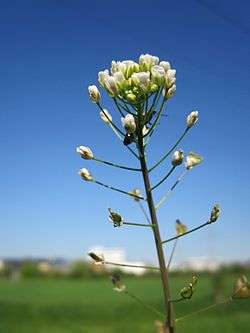Definify.com
Definition 2026
薺
薺
Translingual
Han character
薺 (radical 140 艸+14, 20 strokes, cangjie input 廿卜X (TYX), four-corner 44223)
References
- KangXi: page 1063, character 8
- Dai Kanwa Jiten: character 32208
- Dae Jaweon: page 1527, character 34
- Hanyu Da Zidian: volume 5, page 3315, character 11
- Unihan data for U+85BA
Chinese
| trad. | 薺 | |
|---|---|---|
| simp. | 荠 | |
Glyph origin
| Characters in the same phonetic series (齊) (Zhengzhang, 2003) | |
|---|---|
| Old Chinese | |
| 儕 | *zriːl |
| 麡 | *zriːl, *ʔsliːl, *zliːl |
| 齋 | *ʔsriːl |
| 穧 | *ʔsleds, *ʔsliːls, *zliːls |
| 擠 | *ʔsliːl, *ʔsliːls |
| 躋 | *ʔsliːl, *ʔsliːls |
| 齏 | *ʔsliːl |
| 齎 | *ʔsliːl, *ʔslil |
| 櫅 | *ʔsliːl |
| 齌 | *ʔsliːl, *sʰliːl, *zliːls |
| 隮 | *ʔsliːl, *ʔsliːls |
| 賷 | *ʔsliːl |
| 虀 | *ʔsliːl |
| 濟 | *ʔsliːlʔ, *ʔsliːls |
| 癠 | *ʔsliːlʔ, *zliːl, *zliːlʔ, *zliːls |
| 霽 | *ʔsliːls |
| 齊 | *zliːl, *zliːls |
| 臍 | *zliːl |
| 蠐 | *zliːl, *zlil |
| 懠 | *zliːl, *zliːls |
| 薺 | *zliːlʔ, *zlil |
| 鱭 | *zliːlʔ |
| 嚌 | *zliːls |
| 劑 | *zliːls, *ʔslel |
| 齍 | *ʔslil |
Pronunciation
- Mandarin
- (Standard Chinese, Beijing)+
- Pinyin:
- Zhuyin: ㄐㄧˋ
- Wade-Giles: chih4
- Gwoyeu Romatzyh: jih
- IPA (key): /t͡ɕi⁵¹/
- (Standard Chinese, Beijing)+
- Cantonese
- (Standard Cantonese, Guangzhou)+
- Jyutping: cai5, cai4
- Yale: cháih, chàih
- Cantonese Pinyin: tsai5, tsai4
- IPA (key): /t͡sʰɐi̯¹³/, /t͡sʰɐi̯²¹/
- (Standard Cantonese, Guangzhou)+
| Rime | ||
|---|---|---|
| Character | 薺 | 薺 |
| Reading # | 1/2 | 2/2 |
| Initial (聲) | 從 (15) | 從 (15) |
| Final (韻) | 脂 (15) | 齊 (39) |
| Tone (調) | Level (Ø) | Rising (X) |
| Openness (開合) | Open | Open |
| Division (等) | III | IV |
| Fanqie | 疾資切 | 徂禮切 |
| Reconstructions | ||
| Zhengzhang Shangfang |
/d͡ziɪ/ | /d͡zeiX/ |
| Pan Wuyun |
/d͡zi/ | /d͡zeiX/ |
| Shao Rongfen |
/d͡zjɪ/ | /d͡zɛiX/ |
| Edwin Pulleyblank |
/d͡zi/ | /d͡zɛjX/ |
| Li Rong |
/d͡zi/ | /d͡zeiX/ |
| Wang Li |
/d͡zi/ | /d͡zieiX/ |
| Bernard Karlgren |
/d͡zʱi/ | /d͡zʱieiX/ |
| Expected Mandarin Reflex |
cí | jì |
| Baxter-Sagart system 1.1 (2014) | |
|---|---|
| Character | 薺 |
| Reading # | 1/1 |
| Modern Beijing (Pinyin) |
jì |
| Middle Chinese |
‹ dzejX › |
| Old Chinese |
/*dzˤ[ə]jʔ/ |
| English | Capsella bursa-pastoris |
Notes for Old Chinese notations in the Baxter-Sagart system: * Parentheses "()" indicate uncertain presence; | |
| Zhengzhang system (2003) | ||
|---|---|---|
| Character | 薺 | 薺 |
| Reading # | 1/2 | 2/2 |
| No. | 10058 | 10071 |
| Phonetic component |
齊 | 齊 |
| Rime group |
脂 | 脂 |
| Rime subdivision |
1 | 1 |
| Corresponding MC rime |
薺 | 茨 |
| Old Chinese |
/*zliːlʔ/ | /*zlil/ |
Definitions
薺
- This term needs a translation to English. Please help out and add a translation, then remove the text
{{rfdef}}.
Compounds
Japanese
Kanji

薺 (nazuna): the flower of the shepherd's purse.
薺
Readings
Etymology
| Kanji in this term |
|---|
| 薺 |
|
なずな Hyōgaiji |
| kun'yomi |
/nad͡zuna/ > /nazuna/
Unclear. There are two leading theories, based on older form nadzuna:
- May be derived from natsu na, as in 夏 (natsu, “summer”) + 無 (na, “missing, gone”), from the way the plant dies back in the summer.
- May be derived from nadzuru na, as in 撫づる (nadzuru, “to pet, to pat, to stroke”, the 連体形 (rentaikei, “attributive form”) of Old Japanese verb 撫づ nadzu, modern Japanese 撫でる naderu) + 菜 (na, “edible greens”), from the way the flower clusters may invite handling.
Pronunciation
Noun
薺 (hiragana なずな, katakana ナズナ, romaji nazuna, historical hiragana なづな)
Usage notes
As with many terms that name organisms, this term is often spelled in katakana in biological contexts, as ナズナ.
References
- ↑ 2006, 大辞林 (Daijirin), Third Edition (in Japanese), Tōkyō: Sanseidō, ISBN 4-385-13905-9
- ↑ 1998, NHK日本語発音アクセント辞典 (NHK Japanese Pronunciation Accent Dictionary) (in Japanese), Tōkyō: NHK, ISBN 978-4-14-011112-3
- 1988, 国語大辞典(新装版) (Kokugo Dai Jiten, Revised Edition) (in Japanese), Tōkyō: Shogakukan
Korean
Hanja
薺 • (je) (hangeul 제, revised je, McCune-Reischauer che, Yale cey)
- This term needs a translation to English. Please help out and add a translation, then remove the text
{{rfdef}}.